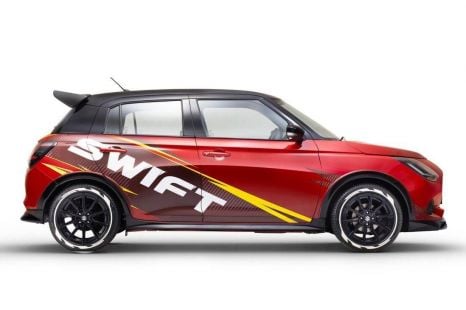

Max Davies
Suzuki Australia wants more diverse models, including sportier Swift
1 Month Ago
The new-generation 2025 Suzuki Swift has arrived as Australia’s cheapest hybrid vehicle.
Priced from $24,490 drive-away, the new Swift Hybrid features a three-cylinder petrol engine and 12V mild-hybrid system across the range, which both extends the idle stop-start function and also provides electrical assistance to the combustion engine when taking off and under load.
There are three trim levels in Australia, and the base model is offered with both five-speed manual and CVT auto transmissions, bringing the variant count to four.
Key rivals include the recently launched MG 3 Hybrid+ (from $27,990) and the Toyota Yaris Hybrid (from $28,500).
Combined fuel consumption is rated at a thrifty 3.9L/100km for the manual, and 4.0L/100km for CVT models. That bisects the Yaris Hybrid (3.3L/100km) and the MG 3 Hybrid+ (4.3L/100km).
Quickly see how this car stacks up against its competition. Select any benchmark to see more details.
Where expert car reviews meet expert car buying – CarExpert gives you trusted advice, personalised service and real savings on your next new car.
| Configuration | Price From* |
|---|---|
| 1.2L, 5-speed manual, 5-door Hatchback, Petrol, FWD | $23,490 |
| 1.2L, Automatic, 5-door Hatchback, Petrol, FWD | $24,490 |
| 1.2L, Automatic, 5-door Hatchback, Petrol, FWD | $25,490 |
| 1.2L, 5-speed manual, 5-door Hatchback, Petrol, FWD | $24,490 |
| Configuration | Price From* |
|---|---|
| 1.2L, 5-speed manual, 5-door Hatchback, Petrol, FWD | $24,490 |
| 1.2L, Automatic, 5-door Hatchback, Petrol, FWD | $25,490 |
| 1.2L, Automatic, 5-door Hatchback, Petrol, FWD | $25,990 |
| Configuration | Price From* |
|---|---|
| 1.2L, Automatic, 5-door Hatchback, Petrol, FWD | $25,990 |
| Configuration | Price From* |
|---|---|
| 1.2L, Automatic, 5-door Hatchback, Petrol, FWD | $25,990 |
| Configuration | Price From* |
|---|---|
| 1.2L, Automatic, 5-door Hatchback, Petrol, FWD | $26,990 |
| 1.2L, Automatic, 5-door Hatchback, Petrol, FWD | $27,490 |
| Configuration | Price From* |
|---|---|
| 1.2L, Automatic, 5-door Hatchback, Petrol, FWD | $26,990 |
| 1.0L, 6-speed auto, 5-door Hatchback, Petrol, FWD | $32,490 |
| Configuration | Price From* |
|---|---|
| 1.0L, 6-speed auto, 5-door Hatchback, Petrol, FWD | $29,790 |
| 1.2L, Automatic, 5-door Hatchback, Petrol, FWD | $27,990 |
| 1.2L, Automatic, 5-door Hatchback, Petrol, FWD | $29,490 |
| 1.2L, Automatic, 5-door Hatchback, Petrol, FWD | $28,990 |
| Configuration | Price From* |
|---|---|
| 1.0L, 6-speed auto, 5-door Hatchback, Petrol, FWD | $29,790 |
| Configuration | Price From* |
|---|---|
| 1.4L, 6-speed manual, 5-door Hatchback, Petrol, FWD | $31,490 |
| 1.4L, 6-speed manual, 5-door Hatchback, Petrol, FWD | $29,990 |
| 1.4L, 6-speed auto, 5-door Hatchback, Petrol, FWD | $33,490 |
| 1.4L, 6-speed auto, 5-door Hatchback, Petrol, FWD | $31,990 |
Where expert car reviews meet expert car buying – CarExpert gives you trusted advice, personalised service and real savings on your next new car.
See our comprehensive details for the Suzuki Swift
The dimensions shown above are for the base model.
See all 2025 Suzuki Swift DimensionsRear seats position | Size |
|---|---|
Rear seats raised | 265L |
Rear seats folded | 589L |
980L (Max volume) |
Where expert car reviews meet expert car buying – CarExpert gives you trusted advice, personalised service and real savings on your next new car.
CarExpert High Resolution Photos of the Suzuki Swift
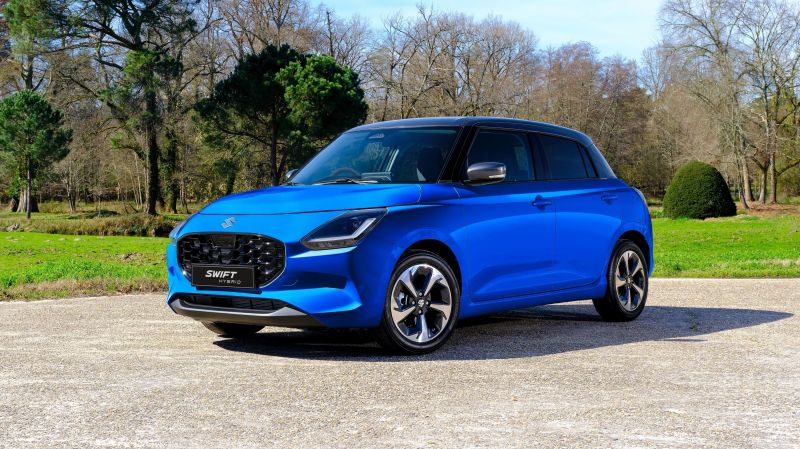
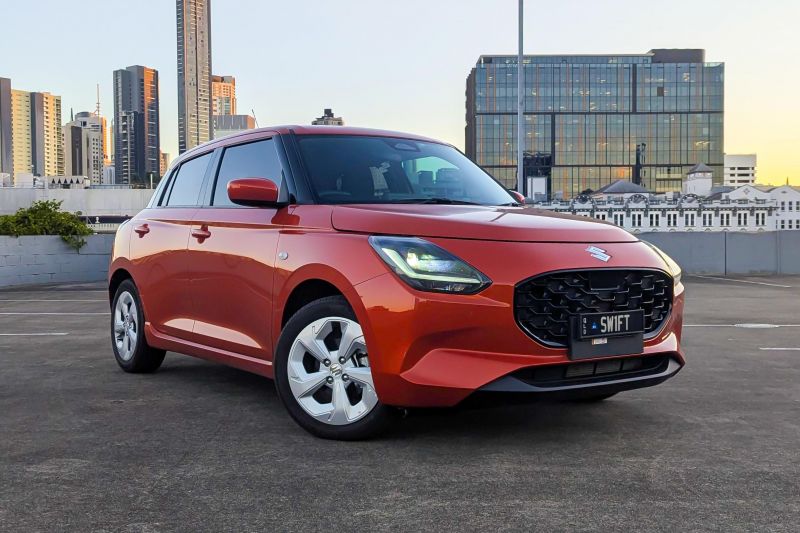
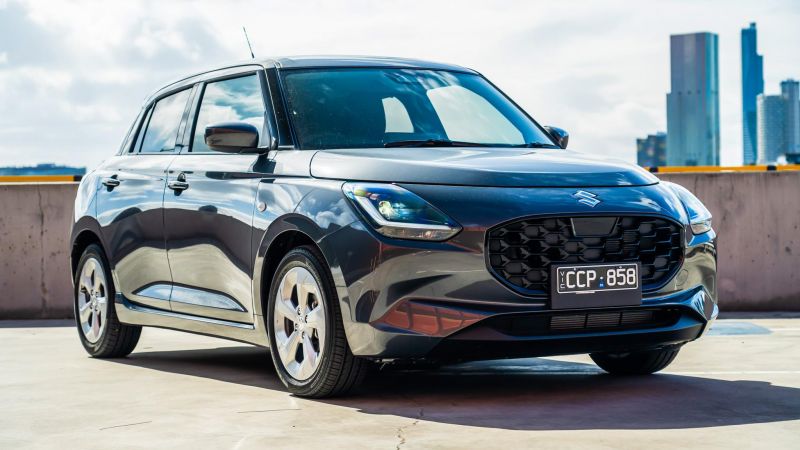
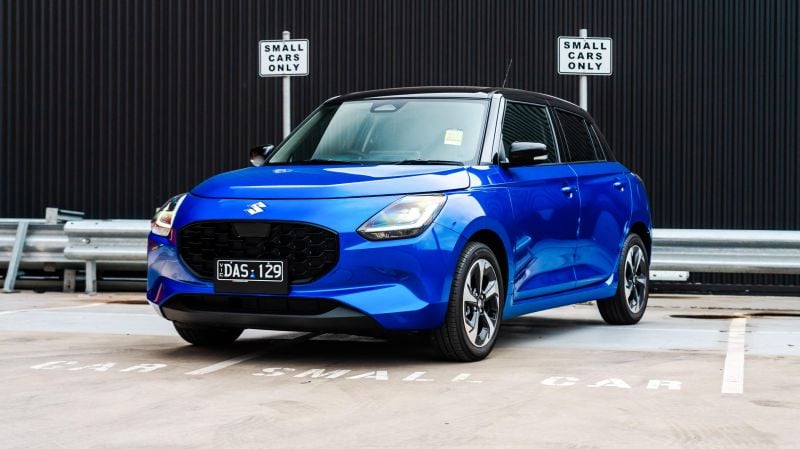
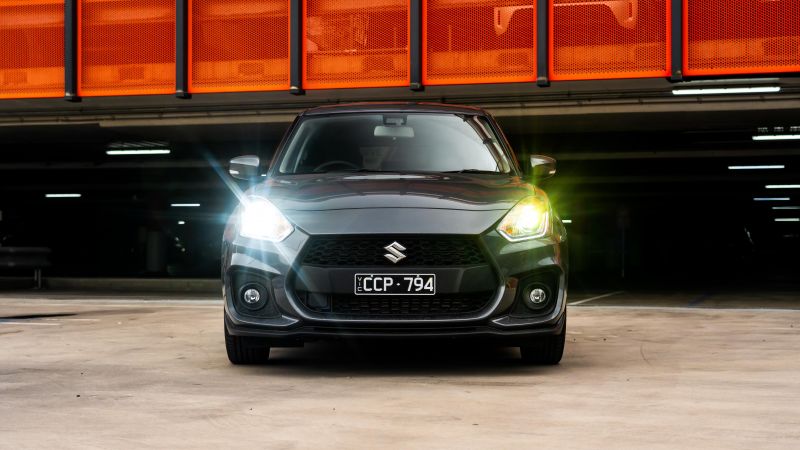
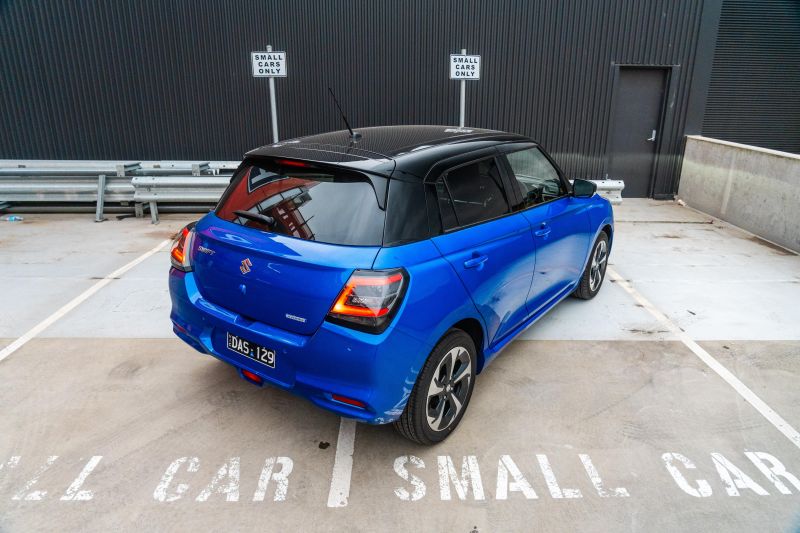
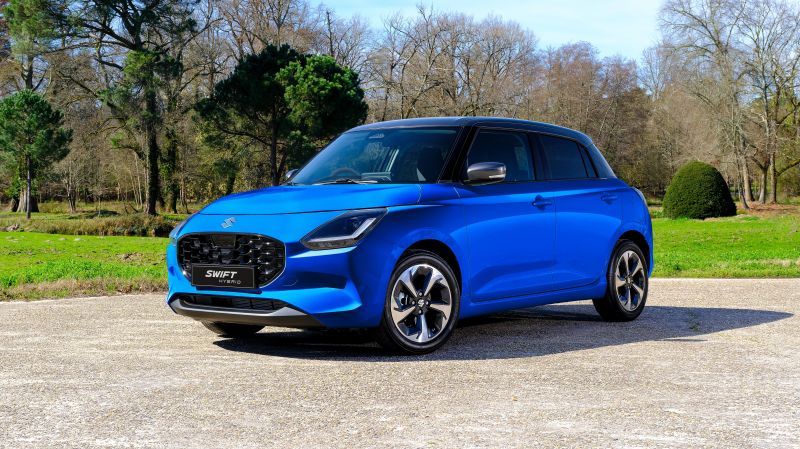
View 7 images
The new Swift maintains an evolutionary approach to design, closely following in the footsteps of its predecessor rather than undergoing a radical transformation.
Like the previous generation, the Swift may not excel in material quality or cabin tactility, but it offers solid ergonomics, practical technology, and spacious interior packaging, all within its compact dimensions.
Key design changes are primarily focused on the dashboard, which now features a freestanding display above toggle-like switchgear, depending on the variant. This replaces the previous integrated touchscreen and circular HVAC controls. The updated interior also includes a chunky steering wheel and a revised instrument cluster with analogue dials for the tachometer and speedometer, now complemented by a digital speedometer readout in the supervision display.
Overall, the interior prioritises simplicity and functionality, which will appeal to many in this market segment. Across all three variants, the base Swift Hybrid is notable for lacking a leather-wrapped steering wheel, but the comfort and tactile quality of the main touchpoints are commendable given the price point. The front seats are soft yet supportive, with an almost sporty design that offers better shoulder support than the basic seats found in some competitors.
A signature feature of the Swift is its tall, boxy proportions, which contribute to a light and airy cabin feel despite the vehicle’s compact size. However, it does not match the perceived quality of a VW Polo, as the interior predominantly features hard plastics and lacks a front-centre armrest. There are, however, lightly padded fabric-lined elbow rests on the front doors, aligning with the vehicle's budget-friendly nature.
The open cabin layout provides practical storage options, including various cubbies, shelves, and generous bottle holders in the doors. GLX variants also include a wireless phone charger positioned ahead of the gear selector.
While the previous Swift was not particularly cramped in the second row, slight increases in dimensions have resulted in a rear seat that comfortably accommodates average-sized adults. Even taller individuals, around 6’1”, can find adequate leg, knee, and headroom. Although it doesn’t match the space offered by a VW Polo or Skoda Fabia, the Swift’s smart packaging ensures rear passengers can sit comfortably.
Rear amenities are limited but include a rear heater duct on GLX models and bottle holders in the doors for all variants. The rear seats also offer ISOFIX and top tether anchorages for child seats.
Boot space is a compact 265 litres, which is 23 litres more than the previous model, expanding to 589 litres with the seatbacks folded up to the window line. The boot floor is deep, resulting in a notable step up to the folded rear seats, consistent with the previous design.
The infotainment system comes equipped with navigation, DAB radio, and wireless Apple CarPlay as standard across the range. Although the native interface can be somewhat sluggish, it remains well-equipped and functional. The hybrid energy flow diagrams add a useful touch, and the 9.0-inch display is appropriately sized for this class. Wireless Apple CarPlay performed reliably during testing.
There are 6 different fuel economy figures for the Suzuki Swift
The most fuel efficient Suzuki Swift is the GL with a 5-speed Manual which is powered by a 1.2L DUAL INJECTOR and uses 3.8L of unleaded per 100km on the combined cycle.
The Suzuki Swift that uses the most amount of fuel is the Sport with a 6-speed Automatic which is powered by a 1.4L TURBO PETROL DIRECT INJECTION and uses 6.1L of premium unleaded per 100km on the combined rural and urban test cycle.
Below is a table of all the Suzuki Swift variants and their fuel economy figures. Click below the table to see an expansion and additional details, including specific usage for city and highway driving.
| Suzuki Swift | Fuel Type | Combined |
|---|---|---|
| 1.2L, 5-speed manual, 5-door Hatchback, Petrol, FWD | Unleaded | 4.6 L/100km |
| 1.2L, Automatic, 5-door Hatchback, Petrol, FWD | Unleaded | 4.8 L/100km |
| 1.2L, Automatic, 5-door Hatchback, Petrol, FWD | Unleaded | 4.0 L/100km |
| 1.2L, 5-speed manual, 5-door Hatchback, Petrol, FWD | Unleaded | 3.8 L/100km |
What are the running and servicing costs of a Suzuki Swift?
Service Interval | Pricing |
|---|---|
12 months or 15,000km | $319 |
24 months or 30,000km | $429 |
36 months or 45,000km | $409 |
48 months or 60,000km | $449 |
60 months or 75,000km | $349 |
60 months or 90,000km | $649 |
Aftersales Program | Suzuki Swift Hybrid |
|---|---|
Warranty | 5 years, unlimited kilometres |
Roadside assistance | 5 years |
Service program | 5 years or 100,000 kilometres |
Service intervals | 12 months or 15,000 kilometres |
Our expert take on Suzuki Swift drivability.
The Swift nameplate has always been known for its fun driving dynamics, and the new Swift Hybrid continues this legacy with a touch of mild electrification. Although the Swift Hybrid’s power figures—60kW and 110Nm—might seem underwhelming compared to competitors like the Kia Picanto’s naturally aspirated 1.25-litre engine, the Swift's light weight (ranging from 919 to 957kg) allows it to feel more lively than the specifications suggest.
The new 1.2-litre three-cylinder engine produces a pleasing sound, similar to other three-cylinder rivals such as the VW Polo, but without being as intrusive in the cabin as the Toyota Yaris under load. The Swift Hybrid Plus, available only with a CVT, is intelligently calibrated to make the most of the vehicle's modest power, providing adequate acceleration, though it does not match the performance of the Boosterjet variants.
An integrated starter generator (ISG) serves as an electric motor to enhance performance and reduce fuel consumption during takeoff and hard acceleration, contributing an additional 2.3kW and 60Nm. This system operates discreetly, delivering a seamless driving experience without noticeable disruptions. The idle stop-start function is also smooth, shutting off the engine as you come to a stop from about 10km/h and restarting promptly when needed.
While Suzuki Australia has not provided an official 0-100km/h time, the UK model with the same drivetrain is quoted at 11.9 seconds. Although not particularly fast, it is adequate for everyday driving, with a top speed of 170km/h achievable with the CVT—a testament to its capabilities, even on European roads.
A brief test of the base manual variant reveals a fun driving experience, though the five-speed transmission has a slightly rubbery feel and a vague clutch, making it less engaging than some might prefer.
The Swift remains a fun and agile car, with improvements in refinement and insulation over its predecessor. The steering is accurate and direct, with good weighting and responsiveness, allowing the Swift to handle corners with enthusiasm. Similar to vehicles from Mazda, there is a sense of engagement and connection in the Swift's driving experience, even at the base level.
Despite some criticism from global reviews regarding a firm ride, the Australian-spec Swift strikes a commendable balance between comfort and dynamism. Its suspension absorbs bumps and imperfections in the road while maintaining body control and composure through corners. Enhanced sound insulation and improved aerodynamics have also reduced road and wind noise, making the Swift feel more refined on coarser surfaces.
The Swift Hybrid is well-equipped with driver assistance technologies, even at the base level. All models feature adaptive cruise control and lane centring assist (referred to as lane keep assist), providing semi-autonomous capabilities on the highway. CVT variants can bring the vehicle to a complete stop, while manuals disengage at 30km/h. The Plus variant adds blind-spot monitoring and rear cross-traffic alert, enhancing safety when navigating tight spaces or reversing.
Visibility is generally good thanks to the tall glasshouse, though the thick C-pillar can hinder over-the-shoulder visibility, making the addition of blind-spot and cross-traffic monitoring particularly useful.
What is the warranty on a Suzuki Swift?
The Suzuki Swift offers a 5 year unlimited km warranty. This is separate to the warranty on offer under Australian Consumer Law which can be greater for certain parts based on what is deemed as a reasonable period of time.
Is this the right car for you? Out experts buy or not guide.
The Swift has always been a charming option, though the previous model became overpriced towards the end of its lifecycle. The latest version now represents excellent value by comparison.
It has transitioned from being one of the pricier choices in the segment to one of the most affordable, offering a highly efficient drivetrain and EU6 emissions technology for considerably less than more complex competitors.
Despite its mild electrification, the new Swift remains true to its roots as a small, fun, and economical city car. Consistent with its predecessors, it is simple yet enjoyable and highly functional.
With the new MG 3 moving upmarket, the Swift Hybrid now occupies a niche with little competition. It is only slightly more expensive than a Kia Picanto but offers greater size, efficiency, and driving enjoyment, all while being significantly cheaper than the equivalent MG 3 Hybrid+ or Toyota Yaris Hybrid.
While the Swift is not without flaws, there is potential for a more affordable non-hybrid variant like those available in Japan, which could bring the price closer to $20,000. Additionally, offering the manual transmission in the Plus and GLX grades would be a welcome option.
The interior material quality and tactility fall short of class leaders, and the boot space is smaller than that of key rivals. Some buyers might also be concerned about the need for 95 RON fuel, though its efficient use offsets this requirement.
Considering the Swift Hybrid is competitively priced against the new petrol-powered MG 3, with better efficiency than the MG 3 Hybrid+, there is potential for a significant shift in the light car segment towards Japanese options.
In a market where cars are becoming increasingly complex and expensive, the Swift serves as a refreshing reminder that basic, cost-effective, and efficient motoring is still accessible in Australia. It is certainly worth considering.
Where expert car reviews meet expert car buying – CarExpert gives you trusted advice, personalised service and real savings on your next new car.
The cheapest Suzuki Swift is the GL that starts from $23,490.
The most expensive Suzuki Swift is the Sport that starts from $33,490.
The best towing capacity of a Suzuki Swift is 1000 kg offered by the following variants: GL, Base, GL Plus, GL+, Plus, Shadow Line, GLX and GLX Turbo.
The largest Suzuki Swift is the Base which measures 1735mm wide, 3860mm in length and sits 1520mm tall.
The most powerful Suzuki Swift is the Sport which has 103kW of power from its 1.4L TURBO PETROL DIRECT INJECTION engine.
The Suzuki Swift is built in Japan and shipped to Australia.
The heaviest Suzuki Swift is the Sport which weighs 1445 kg (kerb weight).
The Suzuki Swift may use different fuel/energy types based on the variant which includes premium unleaded or unleaded.